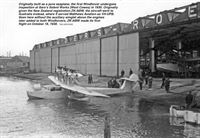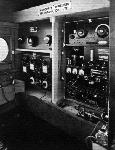
Saro A.21 Windhover
За Saro A.19 Cloud последовала очень похожая летающая лодка A.21 Windhover, построенная в единственном экземпляре. По размерам этот самолет занимал промежуточное положение между A.17 Cutty Sark и A.19. Экипаж состоял из двух человек, пассажировместимость составляла шесть человек.
Возможность установки трех моторов исследовалась на второй лодке A.19 Cloud, на ней установили три мотора de Havilland Gipsy II мощностью по 120 л. с. Над двигателями смонтировали дополнительные аэродинамические поверхности. Лодка Windhover использовалась в 1931-1938 годах.
Описание:
- Saro A.21 Windhover
- Flight, October 1930
THE SARO "WINDHOVER' - Flight, November 1932
British Aircraft
Фотографии
-
Мировая Авиация 229
Лодка Windhover A.21/1 сфотографирована в 1930 году недалеко от базы Солент фирмы «Saro». Заказчиков на гидросамолет не нашлось, возможно, из-за чрезмерной сложности трехмоторной силовой установки.
The new Saro "Windhover" six-seater flying boat (three "Gipsy II" engines) in flight at Cowes. -
Aeroplane Monthly 1991-07 / J.Stroud - Wings of Peace
Регистрационный номер: VH-UPB [5], ZK-ABW [5] The first Saro Windhover as built. It became ZK-ABW, was fitted with a land undercarriage, and went into service as VH-UPB.
-
Aeroplane Monthly 1987-11 / A.Lumsden, T.Heffernan - Per Mare Probare (8)
The prototype Saro Windhover, a six-seater amphibian powered by three Gipsy II engines.
-
Aviation Historian 23 / M.Willis - Trimotors over the Channel
Регистрационный номер: VH-UPB [5], ZK-ABW [5] Originally built as a pure seaplane, the first Windhover undergoes inspection at Saro’s Solent Works (West Cowes) in 1930. Originally given the New Zealand registration ZK-ABW, the aircraft went to Australia instead, where it served Matthews Aviation as VH-UPB. Seen here without the auxiliary winglet above the engines later added to both Windhovers, ZK-ABW made its first flight on October 16, 1930.
-
Flight 1930-10 / Flight
THE SARO AMPHIBIAN FAMILY: On the left is the "Cutty Sark," in the centre the latest "Windhover," and on the right the "Cloud."
Другие самолёты на фотографии: Saunders-Roe Cloud / A.19 - Великобритания - 1930Saunders-Roe Cutty Sark / A.17 - Великобритания - 1929
-
Flight 1931-11 / Flight
THE MEANS. The Saro "Windhover" (three Gipsy II's) at anchor in Gibraltar harbour. Beyond her is a Dornier "Wal" which operates on the line Gibraltar to Genoa, meeting the New York mail boat on her outward trip and then remaining at Gibraltar until the incoming ship arrives.
Другие самолёты на фотографии: Dornier Do.J Wal - Германия - 1922
-
Aviation Historian 23 / M.Willis - Trimotors over the Channel
Регистрационный номер: G-ABJP [5] Windhover G-ABJP while in service with Channel Islands Airways, the holding company for Jersey and Guernsey Airways. The aircraft inaugurated services between Guernsey’s St Peter Port and St Brelade’s Bay in Jersey in June 1935 (and to Alderney from August), the fare being set at 12s for a single journey and 18s return.
-
Aviation Historian 23 / M.Willis - Trimotors over the Channel
Only two Saro Windhovers were built, Jersey Airways acquiring the second, G-ABJP (c/n A.21/2) in May 1935 from the Hon Mrs Victor Bruce, who is seen here in the aircraft preparing for one of her several attempts on the world flight-refuelling endurance record in 1932.
-
Aeroplane Monthly 1991-07 / J.Stroud - Wings of Peace
Регистрационный номер: G-ABJP [5] G-ABJP, the second Windhover, with auxiliary wing.
-
Aeroplane Monthly 1991-07 / J.Stroud - Wings of Peace
Регистрационный номер: G-ABJP [5] G-ABJP at Gibraltar while operating Gibraltar Airways’ services to Tangier. It was named General Godley at the time.
-
Aviation Historian 23 / M.Willis - Trimotors over the Channel
Регистрационный номер: G-ABJP [5] The second Saro Windhover, G-ABJP, in the company’s East Cowes hangar in the early summer of 1931. Before being acquired by The Hon Mrs Victor Bruce, it was owned by millionaire Francis Francis, who sold it in September 1931 to Gibraltar Airways for use on its Gibraltar-Tangier service.
-
Jane's All the World Aircraft 1980 / Encyclopedia of Aviation - Aircraft A-Z - v5
Регистрационный номер: G-ABJP [5] Saro Windhover.
-
Flight 1932-12 / Flight
Регистрационный номер: VH-UPB [5], ZK-ABW [5] FOR NEW ZEALAND SERVICE: A Saro "Windhover" flying boat used for the Victoria-Tasmania trip.
-
Aeroplane Monthly 1987-11 / A.Lumsden, T.Heffernan - Per Mare Probare (8)
Регистрационный номер: VH-UPB [5], ZK-ABW [5] Another view of the first Windhover, with aerofoil added and after delivery to Matthews Aviation Company at Hobart, Tasmania. Re-registered VH-UPB, the aircraft was wrecked off King Island in the Bass Strait in May 1936.
-
Flight 1933-10 / Flight
Регистрационный номер: VH-UPB [5], ZK-ABW [5] AMPHIBIOUS: The Saro "Windhover" amphibian (three "Gipsy II") leaving Melbourne en route for Launceston via King Island.
-
Flight 1932-07 / Flight
Marconi light-weight telephone equipment. Type A.D. 22B, fitted in Mrs. Victor Bruce's "Windhover."
-
Flight 1932-07 / Flight
The Marconi A.D.18A equipment in the Morris 10 cwt. The long-wave receiver is on the left and the transmitter and short-wave receiver on the right.
- Фотографии
















